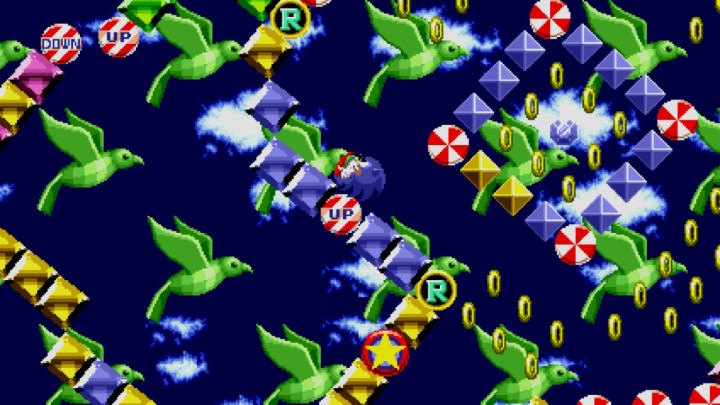I’ve been a Sonic the Hedgehog fan since November 2003 after my cousin Nicholas reintroduced me to Sonic Adventure 2: Battle, the GameCube port of the Dreamcast game. Around that time, Sonic Team was gearing up for the release of Sonic Heroes, which excited nine-year-old me despite the fact that I barely played through the story mode for Sonic Adventure 2.
Although I eventually learned the history behind the Sonic the Hedgehog franchise from every gaming magazine I could get my hands on, my strong obsession with the 3D Sonic games — not to mention modern Sonic’s boy band-like charm — was such that I couldn’t find myself getting into the classic Sonic games from the Sega Genesis (or Mega Drive to my lovely international readers). Even when my ex-boyfriend gave me his old Genesis along with Sonic 1 and Sonic 2 during my first year of college, I couldn’t play through any of them without my screen fuzzing up simply because my TV wouldn’t cooperate with the aging console, cartridge port and all.
Sonic Mania made me appreciate the classic Sonic games despite it being a compilation of the best levels from that era, but the newly released Sonic Origins collection (which features the original Sonic Sega Genesis trilogy and Sonic CD) has given me a newfound appreciation for them thanks to a gameplay mode called Anniversary Mode. It’s a mode where you don’t lose any lives; you can collect coins to redo the special stages as many times as you want to so you could get the Chaos Emeralds. Most modern games have the option to play through them without getting a single “Game Over” after dying so many times, such as Crash Bandicoot 4: It’s About Time, but Anniversary Mode made my experience of playing the classic Sonic games a lot easier than playing them on the Genesis.
That neat feature is something more retro games should adopt if they’re ever re-released and adapted to modern current-gen consoles.
Starting from the Star Post
When I was attempting to play through Sonic 1 in college nearly a decade ago, my experience was terrible. I was having a hard time seeing what I was doing through the static lines flickering down my TV screen (such is the consequence of plugging the ancient Genesis into my modern TV). To make matters worse, I always have to start from Green Hill Zone every time I turn the game on.

My ex told me about a cheat code to input at the title screen to get to the Level Select menu in order to pick the zone I left off of, like Marble Zone or Labyrinth Zone, but I couldn’t press those buttons in time. Not even a YouTube video would help me get out of the endless loop of restarting the game from Green Hill Zone, as iconic as that stage is.
With Anniversary Mode in Sonic Origins, I didn’t have to worry about losing all my progress and starting over from square one in every game. If I was stuck in Labyrinth Zone in Sonic 1 and I exited the game for any reason, I could jump back in hours later and still continue playing from Labyrinth Zone, whether I was starting from Act 1 or wrapping things up in Act 3. There’s still no way to select the levels naturally, but at least I have the option to start over from Green Hill Zone if I wanted to.
Of course, that would only happen if I didn’t get all the Chaos Emeralds.
Mo money, mo Emeralds
In the Genesis Sonic games, playing through all the stages without getting a single “Game Over” was hard enough. Trying to get the Chaos Emeralds in the special stages was an even bigger hassle. While playing Sonic 1, for example, the iridescent labyrinth leading to the Chaos Emerald slowly tilted back and forth, using its cosmic powers to decide whether I should get the Chaos Emerald or fall at a dead end before moving on to the next stage. More often than not, it would lead me to the latter no matter how hard I try to break the barriers protecting the emerald.

Anniversary Mode saved me the pain of getting everything right once with the introduction of Coins. I discovered that once you acquire them somewhere in a stage or as a bonus when you get a high enough score, you can not only spend Coins on unlocking the sketches, pictures, music, and other bonus content you likely already saw on the internet but they can also be spent on redoing the special stages repeatedly until you get the Chaos Emeralds.
And the best part about Coins? Just as you don’t lose any lives, you don’t lose any Coins after you die and respawn. In other words, death and resurrection don’t break the bank. You can take it with you.
Redefining retro
It may be my younger Millennial brain talking, but I need to emphasize how much better the experience has been: Anniversary Mode lets me enjoy those classic Sonic games in a way the Genesis never did. When creating ports like this, developers should take Sonic Origins‘ lead and give older gamers the option they never got as kids to finally conquer their childhood favorites.
Retro games put us through hell in the ’80s well into the 2000s, but Sonic Origins serves as an example of how game design philosophy has evolved past suffering. Retro console games were designed to emulate arcade games, giving players the same challenges as the arcade game they used to sink their allowance into and making it difficult for them to save their progress because of system limitations. Over time, video games shifted to be all about the experience, the fun of it. It’s still important for games to be challenging, but the challenge doesn’t need to be the be-all-end-all of a game. That’s why we now have the technology to recreate retro games in ways that welcome new players and make them more accessible, inclusive, and enjoyable.
It’s not just an important consideration for older players. If those retro games get remastered for modern consoles, those players will be able to introduce their kids to the classics in a much friendlier way. Let them learn with a mode where the stakes are low and switch to a gameplay mode that has a life count system once they’re ready. Just because I had to struggle when I was younger doesn’t mean everyone else should now.
Sonic Origins is available now on PS4, PS5, Xbox One, Xbox Series X/S, PC, and Nintendo Switch.
Editors' Recommendations
- Our favorite Switch games of 2023: Tears of the Kingdom, Mario, and much more
- Alan Wake 2 is proof that more PC games need a potato mode
- Even HBO’s The Last of Us can’t fully master the video game adaptation
- Sonic the Hedgehog 3 will speed into theaters in 2024
- Sonic the Hedgehog turns Fall Guys into Bean Hill Zone for new event




